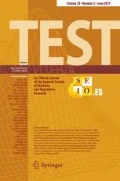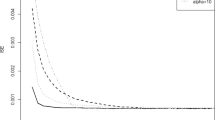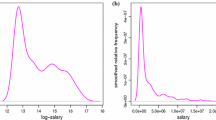Abstract
The identification of peaks or maxima in probability densities, by mode testing or bump hunting, has become an important problem in applied fields. For real random variables, this task has been approached in the statistical literature from different perspectives, with the proposal of testing procedures which are based on kernel density estimators or on the quantification of excess mass. However, none of the existing proposals for testing the number of modes provides a satisfactory performance in practice. In this work, a new procedure which combines the previous approaches (smoothing and excess mass) is presented together with a revision on the previous proposals. The new method is compared with the existing ones in an extensive simulation study, showing a superior behaviour, with good calibration and power results. Theoretical justification for its performance is also obtained. A real data example on philatelic data is also included for illustration purposes, revising previous approaches and discussing the results with the new procedure.


Similar content being viewed by others
Notes
Note that, although asymptotically the sign of \(\widehat{f}''_{h_{\tiny {\text{ PI }}}}(\widehat{x_i})\) is always correct (under the assumptions of Theorem 1), in the finite-sample case, it may not be negative in the modes or positive in the antimodes. In that case, an abuse of notation will be done, denoting as \(h_{\tiny {\text{ PI }}}\) to the critical or other plug-in bandwidth in order to guarantee that the sign of this second derivative remains correct.
References
Chaudhuri P, Marron JS (1999) SiZer for exploration of structures in curves. J Am Stat Assoc 94:807–823
Cheng MY, Hall P (1998) Calibrating the excess mass and dip tests of modality. J R Stat Soc Ser B 60:579–589
Fisher NI, Marron JS (2001) Mode testing via the excess mass estimate. Biometrika 88:419–517
Good IJ, Gaskins RA (1980) Density estimation and bump-hunting by the penalized likelihood method exemplified by scattering and meteorite data. J Am Stat Assoc 75:42–56
Hall P, York M (2001) On the calibration of Silverman’s test for multimodality. Stat Sin 11:515–536
Hartigan JA, Hartigan PM (1985) The dip test of unimodality. Ann Stat 13:70–84
Izenman AJ, Sommer CJ (1988) Philatelic mixtures and multimodal densities. J Am Stat Assoc 83:941–953
Marron JS, Schmitz HP (1992) Simultaneous density estimation of several income distributions. Econom Theory 8:476–488
Minnotte MC, Scott DW (1993) The mode tree: a tool for visualization of nonparametric density features. J Comput Graph Stat 2:51–68
Minnotte MC, Marchette DJ, Wegman EJ (1998) The bumpy road to the mode forest. J Comput Graph Stat 7:239–251
Mitchell JF, Sundberg KA, Reynolds JH (2007) Differential attention-dependent response modulation across cell classes in macaque visual area V4. Neuron 55:131–141
Müller DW, Sawitzki G (1991) Excess mass estimates and tests for multimodality. J Am Stat Assoc 86:738–746
Olden JD, Hogan ZS, Zanden M (2007) Small fish, big fish, red fish, blue fish: size-biased extinction risk of the world’s freshwater and marine fishes. Global Ecol Biogeogr 16:694–701
Roeder K (1990) Density estimation with confidence sets exemplified by superclusters and voids in the galaxies. J Am Stat Assoc 85:617–624
Silverman BW (1981) Using kernel density estimates to investigate multimodality. J R Stat Soc Ser B 43:97–99
Wand MP, Jones MC (1995) Kernel smoothing. Chapman and Hall, Great Britain
Wilson IG (1983) Add a new dimension to your philately. Am Philatel 97:342–349
Author information
Authors and Affiliations
Corresponding author
Additional information
The authors gratefully acknowledge the support of Projects MTM2016-76969-P (Spanish State Research Agency, AEI) and MTM2013-41383-P (Spanish Ministry of Economy, Industry and Competitiveness), both co-funded by the European Regional Development Fund (ERDF), IAP network from Belgian Science Policy. Work of J. Ameijeiras-Alonso has been supported by the Ph.D. Grant BES-2014-071006 from the Spanish Ministry of Economy, Industry and Competitiveness.
Electronic supplementary material
Below is the link to the electronic supplementary material.
Rights and permissions
About this article
Cite this article
Ameijeiras-Alonso, J., Crujeiras, R.M. & Rodríguez-Casal, A. Mode testing, critical bandwidth and excess mass. TEST 28, 900–919 (2019). https://doi.org/10.1007/s11749-018-0611-5
Received:
Accepted:
Published:
Issue Date:
DOI: https://doi.org/10.1007/s11749-018-0611-5




